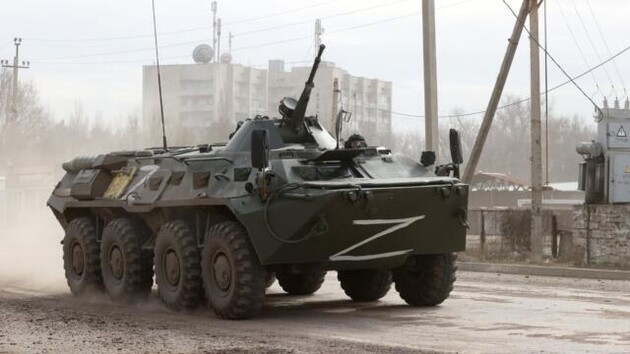The closer the tanks get to the cities, the more vulnerable they become to Ukrainian anti-tank missiles.

The cross on the greenish screen moves slightly to the right, trying to catch a metal hedgehog on the field. The screen goes blank for a moment when the rocket takes off with a characteristic sound. Six seconds pass. BOOM. Another Russian T-72 has been shut down. His crew is probably dead.
This is not about some advanced missiles like Javelin. These are Stugna-P, anti-tank systems that Ukraine makes itself. A small group of soldiers can mount it on a tripod and wait for the tanks to come within range. Using a camera-like remote control panel, the operator can keep the target in sight with a laser until the missile strikes. Or it can allow the system to search for the tank on its own.
According to Business Insider, Ukrainian missiles are quite effective. In three weeks of fighting, Russia has lost at least 270 tanks, according to the Oryx organization, which tracks the armaments of various armies. This is almost 10% of what was in Russia's arsenal. Ukrainian defense proved to be very effective. Analysts believe that the failure of Russia's offensive is due not only to the incompetence of its commanders or tanks, but also to the very idea of tanks as weapons.
Increasing evidence suggests that the tactical weakness of the tanks is “striking.” Therefore, the debate began over whether it was time for such armored vehicles to join the chariots and cavalry at the Museum of Military History. Cheap drones flying at low altitudes destroy from the sky. Soldiers use suburban landscapes in the warehouse to set up ambushes for armored vehicles. And in this they are helped by new weapons, which make the destruction of tanks especially easy. Even untrained volunteers can successfully perform such tasks.
“Infantry ready to go into battle now have an extraordinary opportunity with things like disposable anti-tank missiles,” said military strategist Edward Luttwak, who advises governments around the world.
Tanks have dominated the battlefield for more than 80 years. Their task was to break through the enemy's positions so that the infantry could enter and gain a foothold in the new territory. Tanks have long been vulnerable to weapons that soldiers can carry: RPGs and even hand-held anti-tank grenades.
But it is only necessary to look at the effectiveness of Russian tanks in the attack against Ukraine. It is easy to see how technology, especially advances in guided missile development, is increasing anti-tank capabilities to such an extent that tanks are actually becoming obsolete. The role of the vanguard they are currently playing is likely to shift to drones and robotic technology, as well as long-range systems, in the future.
Missile systems, which can be fired from the shoulder, change the way battles are fought. Javelin allows the operator to quickly aim, fire and hide in cover. These missiles strike tanks from above, where their armor is weakest. Ukraine has even taught its reservists to use Javelin.
The British-Swedish NLAW technology is also not difficult to use. It weighs about as much as a box of beer. So the operator can easily aim from the shoulder in just a few seconds and fire. Then the missile homing system works.
“If any weapon can make a big difference, it's NLAW, a light anti-tank weapon, just a plastic pipe with a cumulative missile. You aim and shoot. One truck can deliver 500 such systems on any street in Kyiv, ”Luttvak said.
And the NLAW system is designed specifically for the type of war that Russia has waged against Ukraine.
“NLAW can attack from almost any position: from the roof of the house to the excavation, you can shoot from behind a tree. You can fire at an angle of 45 degrees from the basement or second floor of the house and far beyond the range of most tanks, “- says the website of the company SAAB, which manufactures these missiles.
The publication writes that as they approach cities, tanks become more and more vulnerable, as soldiers can ambush them. These are not the conditions in which such armored vehicles operated during World War II or in Vietnam.
Ukraine has used the suburbs to deprive Russia of its weapons advantage. The Russian offensive on Kyiv sank in the vicinity, where motivated Ukrainian soldiers met enemy columns. The fighting lasted for weeks. In Irpen, Ukrainian artillery smashed columns of Russian armored vehicles as soon as they entered the field of action. And small groups of soldiers and volunteers set up ambushes, destroying enemy armored vehicles with anti-tank missiles. “Stugni-P” was generally placed in advance along the potential directions of the enemy's movement to break the columns at a distance as soon as they entered.
And there are drones. The war in Ukraine has shown that they really give a huge advantage. They are able to sneak up on enemy armored vehicles and strike with guided missiles. This is exactly what Turkish TB2 Bayraktar is doing again and again. But even smaller drones can make a big difference. Joe Biden's administration is sending 100 Switchblade kamikaze drones to Ukraine, each the size of a backpack. This weapon is capable of flying up to tanks and other equipment, and then deal a crushing blow. The Russian command made blunders, losing the potential of its forces.




